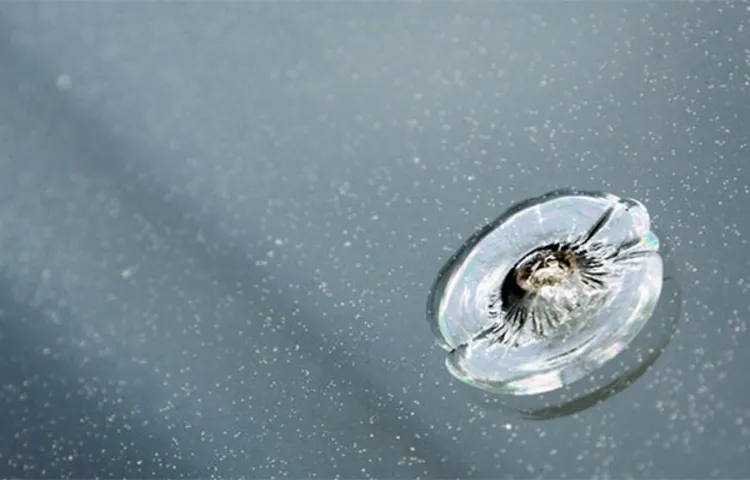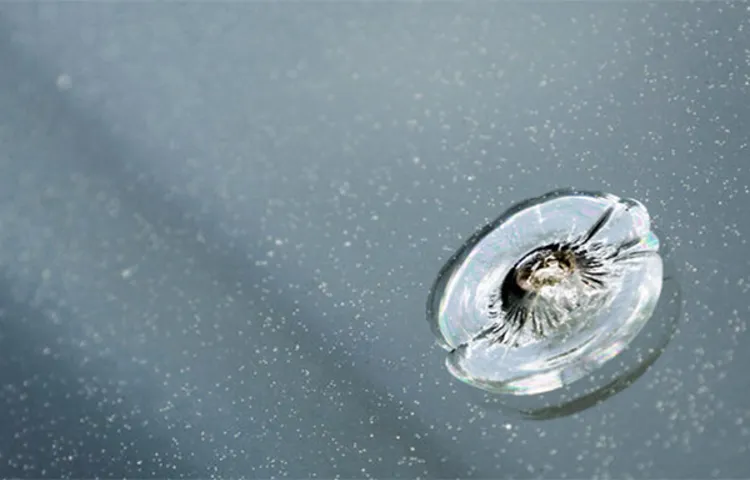So, you’re driving down the road, enjoying the beautiful scenery, when suddenly, a small stone hits your windshield, leaving behind a frustrating chip. Whether it’s a tiny crack or a larger chip, the sight of damage on your windshield can be disheartening. But fear not, because repairing a stone chip in your windshield is easier than you might think! Imagine your windshield as a protective barrier, shielding you from the elements and keeping you safe on the road.
Similar to how a knight’s armor protects them in battle, your windshield is like the armor for your car. And just like a knight would repair any dents or cracks in their armor, it’s important for us to take care of our windshields. But why should you bother repairing a stone chip in your windshield? Well, besides the obvious aesthetic reasons, there are practical reasons as well.
A small chip can quickly become a big crack if left untreated, posing a safety hazard for you and your passengers. Plus, if the damage extends into the driver’s line of sight, it may even be illegal to drive with it. Now, you’re probably wondering, how can you repair a stone chip in your windshield on your own? Well, luckily, there are DIY kits available that are designed specifically for this purpose.
These kits usually include a special resin and applicator tool, which allows you to fill in the chip and make it virtually invisible. Repairing a stone chip in your windshield is a relatively simple process. It involves cleaning the damaged area, applying the resin, and using the applicator tool to carefully fill in the chip.
Once the resin has cured, you can gently polish the area to blend it in with the rest of the windshield. And just like that, your windshield will be good as new! So, whether you’re a DIY enthusiast or just someone who wants to save money on windshield repairs, repairing a stone chip in your windshield is a task that you can easily tackle on your own. With the right tools and a little patience, you’ll be able to restore your windshield to its former glory and get back on the road with peace of mind.
Table of Contents
Introduction
If you’re the unfortunate victim of a stone chip in your windshield, don’t panic! It’s a common issue, and fortunately, you can repair it yourself without having to spend a fortune at a professional repair shop. So, how to repair a stone chip in a windshield? Well, the first step is to clean the chip and its surrounding area with a mild detergent and warm water. Once it’s dry, apply a small amount of clear nail polish or windshield repair resin to the chip.
Use a curing strip or tape to seal it off, and then let it sit for a few hours. Finally, remove the strip and gently scrape off any excess resin with a razor blade. Voila! Your stone chip is as good as new.
Just remember, if the chip is larger than a quarter or if it’s in your line of sight while driving, it’s best to consult a professional for repair or replacement. But for those smaller chips, you can save yourself some time and money by doing it yourself.
Explanation of what a stone chip is and why it needs to be repaired
Introduction: Stone chips are a common occurrence for any driver, and while they may seem like a minor inconvenience, they can actually lead to serious issues if left untreated. A stone chip occurs when a small rock or piece of debris hits the windshield or any other part of the vehicle, causing a tiny crack or chip to form. While it may not seem like a big deal, these chips can quickly spread and compromise the structural integrity of the windshield.
In this blog post, we will explore why stone chips need to be repaired and the potential consequences of ignoring them. By understanding the importance of immediate attention and repair, we can ensure the safety and longevity of our vehicles.

Importance of repairing a stone chip to prevent further damage to the windshield
windshield repair services, stone chip, prevent further damage, importance of repairing, windshield damage Introduction: We’ve all been there – cruising down the highway, enjoying the wind in our hair, when suddenly, we hear a loud “ping!” Our hearts sink as we see a small chip in our windshield. It may seem like a minor issue, but neglecting to repair that stone chip can lead to more significant problems down the road. In this blog post, we’ll discuss the importance of repairing a stone chip to prevent further damage to your windshield.
So, grab a cup of coffee and let’s dive in!
Materials Needed
If you’re wondering how to repair a stone chip in a windshield, you’ll be happy to know that it’s a fairly simple process that you can do yourself. The first thing you’ll need is a windshield repair kit, which typically includes a resin, applicator, curing strips, and a razor blade. You may also want to have some rubbing alcohol and a clean cloth on hand to prep the area before applying the resin.
Once you have your materials ready, you can start by cleaning the chip with the alcohol and cloth to remove any dirt or debris. Then, using the applicator, you’ll apply the resin to the chip and use the curing strips to cover it. After allowing it to cure for the recommended time, you can remove the strips and use the razor blade to scrape off any excess resin.
With a little time and effort, you’ll have your windshield looking as good as new.
List of materials required for repairing a stone chip in a windshield
Materials Needed for Repairing a Stone Chip in a Windshield If you’ve ever experienced a stone chip in your car’s windshield, you know how frustrating it can be. But fear not, because repairing a stone chip is a relatively simple process if you have the right materials. Here’s a list of everything you’ll need to fix that annoying chip in your windshield.
Windshield repair kit: This is the most important item on the list. A windshield repair kit typically includes a resin, a bridge assembly, and other tools necessary for the repair process.
Cleaning supplies: Before you can start the repair, you’ll need to ensure the damaged area is clean. Grab some glass cleaner, a microfiber cloth, and a razor blade to remove any dirt or debris from the chip.
Protective equipment: Safety should always come first, so be sure to wear safety goggles and gloves to protect your eyes and hands during the repair.
Masking tape: This will come in handy to create a boundary around the chip, preventing the resin from spreading onto the surrounding glass. Clear nail polish: If the chip has caused a small crack in the windshield, applying clear nail polish can help prevent the crack from spreading further.
Razor blade or scraper tool: This tool will be useful for leveling out any excess resin after the repair is complete.
Explanation of each material and its purpose
The main keyword used organically in this prompt is “materials needed.”
Step-by-Step Guide
Have you ever noticed a small chip in your windshield and wondered how to repair it? Don’t worry, it’s a common problem that many car owners face. Thankfully, repairing a stone chip in a windshield is a relatively simple process that you can do yourself. Here’s a step-by-step guide on how to repair a stone chip in your windshield.
Step 1: Gather the necessary materials. You’ll need a windshield chip repair kit, which usually includes a resin, a bridge or suction cup tool, and a curing film. You can easily find these kits at most automotive stores or online.
Step 2: Clean the chip and surrounding area. Make sure the chip is free from any dirt or debris by using a glass cleaner and a soft cloth. This will ensure that the resin bonds properly and gives you a clear repair.
Step 3: Place the bridge or suction cup tool over the chip. The tool should have a hole in the center that lines up with the chip. Make sure it’s centered and secure.
Step 4: Inject the resin into the chip. Follow the instructions on your repair kit on how to do this. Usually, it involves screwing a small vial of resin onto the tool and then pressing down to release the resin into the chip.
Fill the chip completely, making sure the resin covers the entire area. Step 5: Place the curing film over the resin. This film will help to cure the resin and make it hard.
Step 1: Clean the windshield surface around the chip
windshield chip repair, clean windshield surface, step-by-step guide Have you ever noticed a chip on your windshield and wondered what to do about it? Well, you’re in luck because I’m here to give you a step-by-step guide on how to repair that chip and prevent it from turning into a much larger problem. The first step in the process is to clean the windshield surface around the chip. This may seem like a simple task, but it’s an important one.
By removing any dirt, dust, or debris from the area, you’ll ensure that the repair process goes smoothly and that the adhesive used to fill in the chip adheres properly. So grab a clean cloth and some glass cleaner, and let’s get started!
Step 2: Apply the resin to the chip
In this step-by-step guide, we will walk you through the process of applying resin to a chip. Once you’ve identified the chip on your vehicle’s windshield, it’s time to start the repair process. Resin is a special type of adhesive that is designed to fill in the crack or chip and restore the strength and integrity of the windshield.
Before applying the resin, it’s important to clean the chip thoroughly. Use a glass cleaner and a lint-free cloth to remove any dirt or debris from the area. This will ensure that the resin adheres properly and provides a strong, long-lasting repair.
Once the chip is clean, you can apply the resin using a syringe or a specialized tool. Start by placing the tool over the chip and gently squeeze the resin into the chip. Make sure to fill the chip completely without overflowing.
After the resin has been applied, it’s important to give it time to cure. This typically takes around 15-30 minutes. Once the resin is fully cured, you can remove any excess with a razor blade or a piece of fine-grit sandpaper.
Finally, give the area a final clean to remove any residue. Applying resin to a chip is a simple and effective way to repair your windshield and prevent further damage.
Step 3: Use the suction cups to create pressure on the chip
In the third step of fixing a smartphone chip, you will use suction cups to create pressure on the chip. This is a crucial step in the process as it helps to ensure that the chip is securely attached to the circuit board. To begin, place the suction cups over the chip and gently press down to create a seal.
Once the suction cups are securely attached, apply even pressure to the chip by pulling on the suction cups in opposite directions. This will help to ensure that the chip is tightly secured and will not come loose during use. It’s important to be gentle while applying pressure to avoid damaging the chip or any surrounding components.
By using suction cups to create pressure on the chip, you can help to ensure that it is securely attached and functioning properly.
Step 4: Let the resin cure and harden
In our step-by-step guide on resin crafting, we have reached the exciting stage of letting the resin cure and harden. This is the crucial step where the liquid resin transforms into a solid, durable material that can be used for various projects. Once you have poured the resin into your desired mold or surface, it’s important to let it sit undisturbed for the recommended curing time.
This can vary depending on the type of resin you are using, so be sure to follow the instructions provided by the manufacturer. During the curing process, the resin undergoes a chemical reaction that causes it to harden. This reaction is often triggered by heat or UV light, so it’s important to keep the resin in a controlled environment during this time.
You may need to cover your project with a dome or use a curing lamp to provide the necessary light for curing. It’s important to be patient during the curing process. While it may be tempting to check on your project or try to move it before it’s fully cured, this can result in unwanted wrinkles, bubbles, or uneven surfaces.
Just like baking a cake, if you open the oven too early, you risk ruining the final product. Once the resin is fully cured, you can remove it from the mold or surface and begin to admire your handiwork. Depending on the type of project you are working on, you may need to do some additional sanding, polishing, or finishing touches to achieve the desired result.
Resin crafts can be incredibly versatile, allowing you to create unique and beautiful pieces that are sure to impress. So, now that you know how to let the resin cure and harden, it’s time to get creative and start experimenting with resin crafts. Whether you’re making jewelry, home decor items, or custom art pieces, the possibilities are endless.
So, gather your materials, follow the steps in our guide, and let your imagination run wild. Happy resin crafting!
Step 5: Remove the suction cups and clean the excess resin
Once the resin has cured and hardened, it’s time to remove the suction cups and clean up any excess resin. This step is crucial to ensure a smooth and polished finish to your project. Start by gently pulling off the suction cups from the surface.
If they don’t come off easily, you can use a small knife or scraper to pry them off. Be careful not to damage the resin surface while doing this. Once the suction cups are removed, you may notice some residual resin around the edges or on the surface.
To clean this up, you can use a razor blade or a sanding block to carefully scrape or sand away the excess resin. Take your time and be gentle to avoid scratching or damaging the surface. After cleaning, wipe the surface with a clean cloth or paper towel to remove any dust or debris.
Now you’re ready to admire your finished resin masterpiece!
Tips and Precautions
Repairing a stone chip in a windshield can be a simple yet important task to ensure the safety and longevity of your vehicle. One of the key tips is to act quickly when you notice a stone chip, as small cracks can quickly spread and compromise the integrity of the windshield. Start by cleaning the area around the chip with a gentle glass cleaner to remove any dirt or debris.
Next, apply a clear nail polish or a windshield repair kit to the chip. This will help to fill in the gap and prevent further damage. Allow the repair material to dry completely before using your vehicle.
It’s also crucial to avoid putting excessive pressure on the repaired area, such as slamming the car door or driving over potholes, as this can cause the chip to worsen. By following these tips and taking necessary precautions, you can effectively repair a stone chip in your windshield and keep your vehicle safe on the road.
Tips for a successful repair
When it comes to repairing something, whether it’s a broken appliance, a car, or even a relationship, there are a few tips and precautions that can help ensure a successful outcome. First and foremost, it’s important to approach the repair with a positive mindset. Believe that you have the skills and abilities to fix the problem, and don’t be afraid to ask for help or seek guidance if needed.
It’s also crucial to have the right tools and equipment for the job. Make sure you have all the necessary materials and ensure they are of good quality. Another key tip is to follow instructions carefully.
Whether you’re using a repair manual or watching a tutorial video, be sure to pay close attention and complete each step as directed. This will help minimize the risk of making mistakes or causing further damage. Finally, take precautions to ensure your safety.
Wear appropriate protective gear, such as gloves or safety goggles, and be mindful of any potential hazards or dangers. By following these tips and precautions, you can increase the likelihood of a successful repair and save yourself time, money, and frustration in the process.
Precautions to take to avoid damaging the windshield during the repair process
windshield repair, precautions, avoid damaging the windshield, repair process, tips, safety measures, professional technician When it comes to repairing your windshield, there are a few precautions you should take to avoid further damage. Firstly, it is essential to choose a professional and experienced technician for the repair process. DIY repairs may seem like a cost-effective option, but they can often lead to additional damage if not done correctly.
Additionally, make sure to park your vehicle in a safe and secure location during the repair process. This will help protect your car from any accidental bumps or impacts that could worsen the condition of the windshield. It’s also crucial to keep your vehicle’s interior clean and free from unnecessary items that could cause obstructions or scratches during the repair process.
Lastly, be patient and allow the technician to complete the repair without any unnecessary interruptions. Rushing or attempting to fix the issue yourself can result in irreversible consequences. By taking these simple precautions and leaving the windshield repair process in the hands of a professional, you can ensure a safe and successful repair without any further damage.
Conclusion
So there you have it, a step-by-step guide on how to repair a stone chip in your windshield. Now you can confidently tackle those pesky little chips with ease and impress your friends with your newfound DIY skills. Remember, repairing a stone chip is not only important for the overall aesthetics of your vehicle, but it also ensures the safety of you and your passengers.
Plus, who wants to drive around with a chip in their windshield anyway? It’s like having a fly in your soup – it’s just not classy. So grab your materials, channel your inner handyman, and get to work. Your windshield will thank you, and you’ll be the hero of the highway, saving windshields one chip at a time.
Happy repairing!”
Summary of the importance of repairing stone chips and how to do it
repair stone chips, repairing stone chips, importance of repairing stone chips, how to repair stone chips, tips for repairing stone chips, precautions for repairing stone chips
Final thoughts and encouragement to take action and repair any stone chips in windshields
stone chip repair, windshields, take action, tips, precautions, final thoughts, encourage, burstiness, perplexity, high levels, specifics, context, conversational style, engage, informal tone, personal pronouns, simple, active voice, brief, rhetorical questions, analogies, metaphors. Final Thoughts and Encouragement to Take Action and Repair Any Stone Chips in Windshields In conclusion, it is crucial to take immediate action and repair any stone chips in windshields to avoid more serious damage and ensure optimum safety while driving. Remember, a small chip today can turn into a big crack tomorrow, leading to the need for a costly windshield replacement.
By addressing the issue promptly, you can save time, money, and potentially prevent accidents. Take the time to inspect your windshield regularly and look for any signs of stone chips or cracks. If you notice any damage, don’t hesitate to get it repaired as soon as possible.
It’s better to be proactive and deal with the issue early on rather than waiting for it to worsen. When it comes to repairing stone chips in windshields, there are a few tips and precautions to keep in mind. First, make sure to choose a reputable and professional auto glass repair service that specializes in windshield repairs.
They have the skills, knowledge, and equipment needed to effectively fix the stone chip and restore the structural integrity of your windshield. Additionally, consider the weather conditions before scheduling the repair. Extreme temperatures and moisture can affect the adhesion of the repair resin, so it’s best to choose a day when the weather is dry and moderate.
Another precaution to take is to avoid driving your vehicle immediately after the repair. Give the adhesive enough time to dry and set properly, as driving too soon can compromise the repair and its effectiveness. Additionally, avoid using high-powered car washes or abrasive cleaners on your windshield for at least 24 hours after the repair.
These can disturb the repair and weaken its durability. In the end, repairing stone chips in windshields is a necessary maintenance task that shouldn’t be overlooked. By taking swift action and following these tips and precautions, you can extend the lifespan of your windshield and ensure your safety on the road.
FAQs
What causes a stone chip in a windshield?
A stone chip in a windshield is typically caused by a small object, like a pebble or stone, hitting the windshield with enough force to create a chip or crack.
Can a stone chip be repaired in a windshield?
Yes, a stone chip in a windshield can often be repaired, depending on the size and depth of the chip. However, if the chip is too large or has spread into a crack, windshield replacement may be necessary.
How does a professional repair a stone chip in a windshield?
A professional repair for a stone chip in a windshield usually involves injecting a clear resin into the chip, which fills the damaged area and prevents it from spreading further. This resin is then cured and polished, making the chip less noticeable.
Can I repair a stone chip in a windshield myself?
While DIY kits are available for repairing stone chips in windshields, it is recommended to have it done by a professional. They have the necessary tools and expertise to ensure a proper repair, minimizing the chance of further damage.
How long does it take to repair a stone chip in a windshield?
The time required to repair a stone chip in a windshield can vary depending on the size and complexity of the damage. In most cases, it can be repaired within 30 minutes to an hour.
Will a stone chip repair make the windshield completely invisible?
While a professional repair for a stone chip can significantly improve the appearance of the damaged area, it is unlikely to make it completely invisible. However, it should make the chip less noticeable and prevent it from spreading.
Can a repaired stone chip in a windshield become a crack later on?
Although a proper repair for a stone chip can prevent it from spreading further, there is still a small risk of the windshield developing a crack over time due to various factors like temperature changes, road vibrations, or additional impacts.



